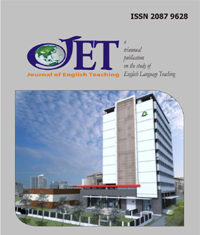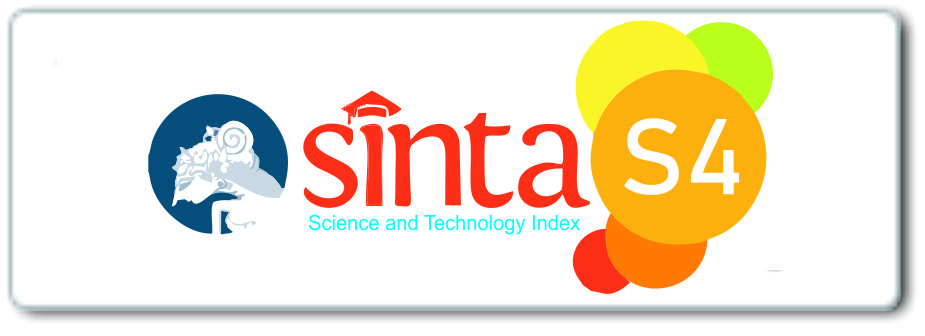Translating Causative Have and Get: A Comparative Study between Google Translate Translation and Human Translation
DOI:
https://doi.org/10.33541/jet.v11i1.6652Keywords:
Causative, Google Translate, tperiphrastic, translationAbstract
Technological advances have made the ability to translate no longer exclusively belong to humans. Today, machine translation has turned into a tool with superior performance to convert text between languages without the need for human intervention. One of the translation research foci is the studies of causative translation, especially from English to several other languages. Yet, it might be interesting to compare the translation of that topic by human and machine translation. This study investigates the comparison of Google Translate and humans in terms of causative translation from English into Indonesian. The data were obtained from six English novels and their translations in Indonesian. To analyze the data, 100 clauses with causative have and get were selected from English novels and translated by Google Translate into Indonesian. The result showed that the translation and strategies used between Google Translate of causative have and get had similarity with human translation in relation to causative-to-causative translation. Through the investigation, the result is expected to be beneficial for further studies in the translation of causative have and get related to their translations into Indonesian analytic or morphological causative. Furthermore, the result of strategies compared is expected to be beneficial to the translation study regarding machine and human translation in causative, especially from English into Indonesian.
References
Afshin, H., & Alaeddini, M. A. (2016). A contrastive analysis of machine translation (Google Translate) and human translation: Efficacy in translating verb tense from English to Persian. Mediterranean Journal of Social Sciences, 7(4), 40–48. https://doi.org/10.5901/mjss.2016.v7n4p40
Arka, I. W. (1993). Morpholexical aspects of the -kan causative in Indonesian [Unpublished master’s thesis]. University of Sydney.
Baron, N. S. (1974). The structure of English causatives. Lingua, 33(4), 299–342. https://doi.org/10.1016/0024
Bassnett, S. (2013). Translation studies. Routledge.
Bellos, D. (2011). Is that a fish in your ear?: Translation and the meaning of everything. Faber and Faber.
Creswell, J. W. (2018). Educational research: Planning, conducting, and evaluating quantitative and qualitative research. Pearson Higher Ed.
Creswell, J. W., & Creswell, J. D. (2018). Research design: Qualitative, quantitative, and mixed methods approaches (5th ed.). Sage Publications.
Dixon, R. M., & Aikhenvald, A. Y. (2000). Changing valency: Case studies in transitivity. Cambridge University Press.
Frawley, W. (1992). Linguistic semantics. Lawrence Erlbaum Associates, Inc.
Gentzler, E. (2001). Contemporary translation theories (Vol. 21). Multilingual Matters.
Ghasemi, H., & Hasemian, M. (2016). A comparative study of Google Translate translations: An error analysis of English-to-Persian and Persian-to-English translations. English Language Teaching, 9(3), 13–17.
Gilquin, G. (2003). Causative get and have: So close, so different. Journal of English Linguistics, 31(2), 125–148. https://doi.org/10.1177/0075424203251995
Gilquin, G. (2008). Causative make and faire: A case of mismatch. In M. A. Gonzalez, J. L. Mackenzie, & M. G. Alvarez (Eds.), Current trends in contrastive linguistics: Functional and cognitive perspectives (Vol. 60, pp. 177–204). John Benjamins Publishing Company.
Gilquin, G. (2015). Contrastive collostructional analysis: Causative constructions in English and French. Zeitschrift für Anglistik und Amerikanistik, 63(3), 253–272.
Hampshire, S., & Salvia, C. P. (2010). Translation and the internet: Evaluating the quality of free online machine translators. Quaderns: Revista de Traducció, 17, 197–209.
Hasibuan, Z. (2020). A comparative study between human translation and machine translation as an interdisciplinary research. Journal of English Teaching and Learning Issues, 3(2), 115–130.
Hurford, J. R., Heasley, B., & Smith, M. B. (2007). Semantics: A coursebook (2nd ed.). Cambridge University Press.
Kemmer, S., & Verhagen, A. (1994). The grammar of causatives and the conceptual structure of events. Cognitive Linguistics, 5(2), 115–156.
Lakoff, G., & Johnson, M. (2003). Metaphors we live by (2nd ed.). University of Chicago Press.
Bassnett, S., & Lefevere, A. (2002). Translation/history/culture: A sourcebook. Routledge.
Levshina, N., Geeraerts, D., & Speelman, D. (2013). Mapping constructional spaces: A contrastive analysis of English and Dutch analytic causatives. Linguistics, 51(4), 825–854.
Moreno, J. C. (1993). "Make" and the semantic origins of causativity: A typological study. In B. Comrie & M. Polinsky (Eds.), Causatives and transitivity (pp. 155–176). John Benjamins Publishing Company.
Munday, J., Pinto, S. R., & Blakesley, J. (2022). Introducing translation studies: Theories and applications. Routledge.
Newmark, P. (1988). A textbook of translation. Prentice Hall International.
Purwo, B. K. (2002). The benefactive and instrumental -kan: Their syntactic ambiguity in the bitransitive and causative constructions. 6th International Symposium on Malay/Indonesian Linguistics (p. 158). Bintan Island, Riau, Indonesia.
Rabab'ah, G. (2008). Communication strategies in translation. International Journal of Translation, 20(2), 97–109.
Sneddon, J. N., Adelaar, A., Djenar, D. N., & Ewing, M. C. (2010). Indonesian reference grammar. Allen & Unwin.
Sutrisno, A. (2020). The accuracy and shortcomings of Google Translate translating English sentences to Indonesia. Education Quarterly Reviews, 3(4). https://doi.org/10.31014/aior.1993.03.04.163
Talmy, L. (2000). Toward a cognitive semantics: Volume 1: Concept structuring systems (Vol. 1). MIT Press.
Tongpoon-Patanasorn, A., & Griffith, K. (2020). Google translate and translation quality: A case of translating academic abstracts from Thai to English. Pasaa, 60(1), 134–163.
van Rensburg, A., Snyman, C., & Lotz, S. (2012). Applying Google Translate in a higher education environment: Translation products assessed. Southern African Linguistics and Applied Language Studies, 30(4), 511–524.
Vinay, J., & Darbelnet, J. (1995). Comparative stylistics of French and English (Vol. 11). John Benjamins Publishing Company.
Downloads
Published
Issue
Section
License
Copyrights for articles published in JET are retained by the authors, with first publication rights granted to the journal. The journal/publisher is not responsible for subsequent uses of the work. It is the author's responsibility to bring an infringement action if so desired by the author.





